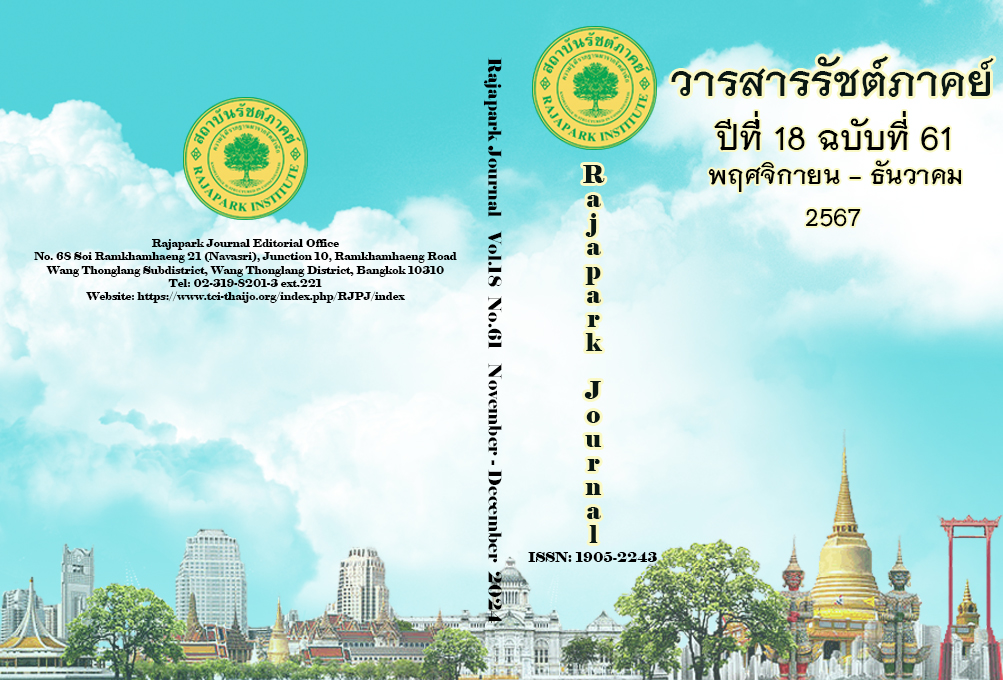Travel Motivations Influencing Generation Y Tourists' Decision to Use Independent Overseas Travel Services in Thailand and the Republic of China (Taiwan)
Main Article Content
Abstract
This research aimed to 1) examine the level of travel motivations influencing Generation Y tourists' decisions to use independent overseas travel services in Thailand and the Republic of China (Taiwan), and 2) test the effects of travel motivations on their decision to use these services. The population consisted of Generation Y tourists with experience using independent overseas travel services in Thailand and Taiwan, with an unknown total population size. The sample size was determined using Cochran's formula (1977) at a 95% confidence level, requiring a minimum of 385 respondents per country. To reduce sampling errors, a total of 800 respondents were surveyed, equally distributed between the two countries with 400 each. This quantitative research utilized questionnaires for data collection. Data analysis employed descriptive statistics, including frequency, percentage, mean, and standard deviation, as well as inferential statistics using multiple regression analysis. The results revealed that 1) the overall level of travel motivation was high (Mean = 4.27, S.D. = 0.60), and 2) travel motivations significantly influenced the decision to use independent travel services (F = 20.916, p < 0.01), explaining 52.20% of the variance in decision-making. Among push factors, destination activities exerted the strongest influence, followed by self-fulfillment and prestige, and travel experience. For pull factors, the quality and diversity of tourism offerings had the most significant impact, followed by historical and cultural attractions, scenic beauty of tourist destinations, accessibility of tourist destinations, value and experiences, tourism promotion policies, and cost of living.
Article Details

This work is licensed under a Creative Commons Attribution-NonCommercial-NoDerivatives 4.0 International License.
Views and opinions appearing in the Journal it is the responsibility of the author of the article, and does not constitute the view and responsibility of the editorial team.
References
Becken, S., & Hay, J. E. (2007). Tourism and climate change: Risks and opportunities. Channel View Publications.
Booking.com. (2023). Travel predictions 2023: Searching for value, embracing the unknown and leaning into wanderlust. https://globalnews.booking.com/bookingcom-reveals-its-travel-predictions-for-2023/
Cavagnaro, E., Staffieri, S., & Postma, A. (2018). Understanding millennials' tourism experience: values and meaning to travel as a key for identifying target clusters for youth (sustainable) tourism. Journal of Tourism Futures, 4(1), 31-42. https://doi.org/10.1108/JTF-12-2017-0058
Chen, H. J., & Chou, S. Y. (2019). Antecedents and consequences of perceived coolness for Generation Y in the context of creative tourism - A case study of the Pier-2 Art Center in Taiwan. Tourism Management, 72, 121-129. https://doi.org/10.1016/j.tourman.2018.11.016
Chua, E.L., Chiu, J.L. & Chiu, C.L. (2020). Factors influencing trust and behavioral intention to use Airbnb service innovation in three ASEAN countries. Asia Pacific Journal of Innovation and Entrepreneurship, 14(2), 175-188. https://doi.org/10.1108/APJIE-12-2019-0095
Cochran, W.G. (1997). Sampling Techniques (3rd ed.). John Wiley & Sons.
Dann, G. M. S. (1977). Anomie, ego-enhancement and tourism. Annals of Tourism Research, 4(4), 184-194. https://doi.org/10.1016/0160-7383(77)90037-8
Davis, B., & Mangan, J. (1992). Family expenditure on hotels and holidays. Annals of Tourism Research, 19(4), 691-699. https://doi.org/10.1016/0160-7383(92)90061-S
Fleischer, A., & Rivlin, J. (2008). More or better? Quantity and quality issues in tourism consumption. Journal of Travel Research, 47(3), 285-294. https://doi.org/10.1177/0047287508321204.
Hair, J. F., Black, W. C., Babin, B. J. & Anderson, R. E. (2010). Multivariate Data Analysis (7th ed.). Prentice Hall.
Hsu, C. H. C., & Huang, S. (2016). Reconfiguring Chinese cultural values and their tourism implications. Tourism Management, 54, 230-242. https://doi.org/10.1016/j.tourman.2015.11.011
Huang, S. (2021). Tourist motivation: A critical overview. Routledge.
Hwang, Y. H., Gretzel, U., & Fesenmaier, D. R. (2006). Multicity trip patterns: Tourists to the United States. Annals of Tourism Research, 33(4), 1057-1078. https://doi.org/10.1016/j.annals.2006.04.004
Hyde, K. F., & Lawson, R. (2003). The nature of independent travel. Journal of Travel Research, 42(1), 13-23. https://doi.org/10.1177/0047287503253944
Kim, S., Choe, J. Y., & Lee, S. (2021). Visual Media and Tourism. Routledge.
Li, Y., Guo, Z., Hua, H., & Li, W. (2024). An empirical analysis of cultural differences in overseas tourism: How do they affect self-determination theory (SDT) needs by age?, International Journal of Intercultural Relations, 99, Article 101936. https://doi.org/10.1016/j.ijintrel.2024.101936
Lin, Y. H., & Zhang., C. (2021). Investigating air travellers’ travel motivation during a pandemic crisis, Journal of Air Transport Management, 97, Article 102138. https://doi.org/10.1016/j.jairtraman.2021.102138
Morrison, A. M. (2013). Marketing and managing tourism destinations. Routledge.
Nicolau, J. L. (2008). Characterizing tourist sensitivity to distance. Journal of Travel Research, 47(1), 43-52. https://doi.org/10.1177/0047287507312414
Nunnally, J. C. (1978). Psychometric theory (2nd ed.). McGraw-Hill.
Prebensen, N. K., Woo, E., Chen, J. S., & Uysal, M. (2013). Motivation and involvement as antecedents of the perceived value of the destination experience. Journal of Travel Research, 52(2), 253-264. https://doi.org/10.1177/0047287512461181
Qiu, R., Masiero, L., & Li, G. (2018). The psychological process of travel destination choice. Journal of Travel & Tourism Marketing. 35(6). 1-15. 10.1080/10548408.2018.1435332
Sangpikul, A. (2008). Travel motivations of Japanese senior travellers to Thailand. International Journal of Tourism Research, 10(1), 81-94. https://doi.org/10.1002/jtr.643
Santos, M., Veiga, C., Santos, J., & Aguas, P. (2022). Sustainability as a success factor for tourism destinations: a systematic literature review. Worldwide Hospitality and Tourism Themes. https://doi.org/10.1108/WHATT-10-2021-0139
Schiopu, A. F., Padurean, A. M., Tala, M. L., & Nica, A. M. (2016). The influence of new technologies on tourism consumption behavior of the millennials. Amfiteatru Economic Journal, 18(Special Issue 10), 829-846. https://www.researchgate.net/publication/311805222_
The_influence_of_new_technologies_on_tourism_consumption_behavior_of_the_millennials
Taiwan Tourism Bureau. (2023). Tourism statistics for 2022. https://admin.taiwan.net.tw/statistics/year.aspx?no=134
Tan, W.K. (2020). Destination selection: Influence of tourists’ personality on perceived travel constraints. Journal of Vacation Marketing, 26(4), 442-456. https://doi.org/10.1177/1356766720942556
Tourism Authority of Thailand. (2023). Thailand tourism statistics 2022. https://www.mots.go.th/news/category/591
UNWTO. (2023). International tourism highlights 2023 edition. https://www.unwto.org/tourism-statistics/key-tourism-statistics
Zhou, Q., Sotiriadis, M., & Shen, S. (2023). Using TikTok in tourism destination choice: A young Chinese tourists' perspective, Tourism Management Perspectives, 46, Article 101101. https://doi.org/10.1016/j.tmp.2023.101101


